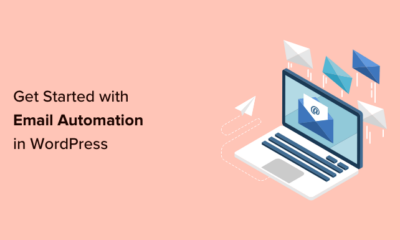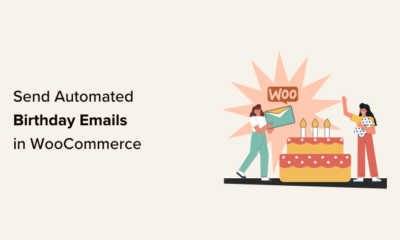EMAIL MARKETING
The science behind email open rates (and how to get more people to read your emails)

- The success of your email campaigns depends on email open rate. If no one opens your email, then you cannot generate new business from email marketing. So, what is a good email open rate?
- We share open rate numbers by industry, by device, by out send time and more – all backed by research from 50 email marketing statistics to help you increase email open rates.
- With our unique case study, we show you how we earn an average 40% email open rate for every single email we send (based on over 99,000 emails sent). Plus, learn how we generated a 94% email open rate!
How do you measure the success of your email campaigns?
The chances are that you measure the success by the number of people who open the mail (email open rate) and the number of people who click on a link (click-through rate).
That’s how I used to measure it.
And while there’s nothing wrong with that, what gets overlooked is that the click-through rate is entirely dependent on the open rate, because unless people open your email, there’s no chance they can click on it!
Therefore, in order to get a better click-through rate, you need people to open your email.
So, how do you get more people to open your email?
There’s a lot of opinions on the web about how to increase email open rates, but I’m only interested in the concrete data behind email open rate success – which is why this article is stacked full of more than 50 email marketing statistics!
Since launching SuperOffice Marketing, we’ve helped thousands of companies use email marketing to engage with their subscribers. It’s also given us access to data and insight on how people open, respond and engage with email campaigns – which we’ll be sharing in this report.
The science and data presented to you in this article will help you get more people to read your email marketing campaigns and help you increase email open rates, which in turn positively impacts the overall performance of your email marketing strategy.
But, first…
What is an email open rate?
Before I dive into the data, you and I need to understand this metric. You see, most people consider the open rate as the number of people who open your email.
Sounds logical, right?
Unfortunately, that’s not the case. An email is only counted as opened when one of the following occurs:
- The reader enables images in your email to be displayed in the preview pane or in a full view of the email.
- The recipient clicks a link in the email.
OK, easy enough. But, how are email open rates calculated?
Email service providers (ESPs) calculate the open rate by taking the number of people who open the email and dividing it by the number of emails sent that did not bounce, i.e. failed to reach the recipient.
For example, if you send 100 emails, and 10 of them bounce, this leaves you with 90 delivered emails. Of those 90 emails, let’s say that 10 are opened. This means that your email campaign open rate is 11% (10 emails opened from 90 delivered).
Emails that are not delivered cannot be opened, which is why this number is not included in the open rate percentage.
What is the average email open rate?
Given that B2B email marketing has been the most popular marketing channel for several years’ and that the average number of promotional emails sent to readers continues to increase, you would think that email open rate is on the decline.
For the most part, that wasn’t the case.
Until 2019, that is.
Between 2015 to 2018, the average open rate for email was steady – hovering at 24% globally.
However, in 2020, the average open rate dropped to 21.3% (a slight decrease compared to 2019).
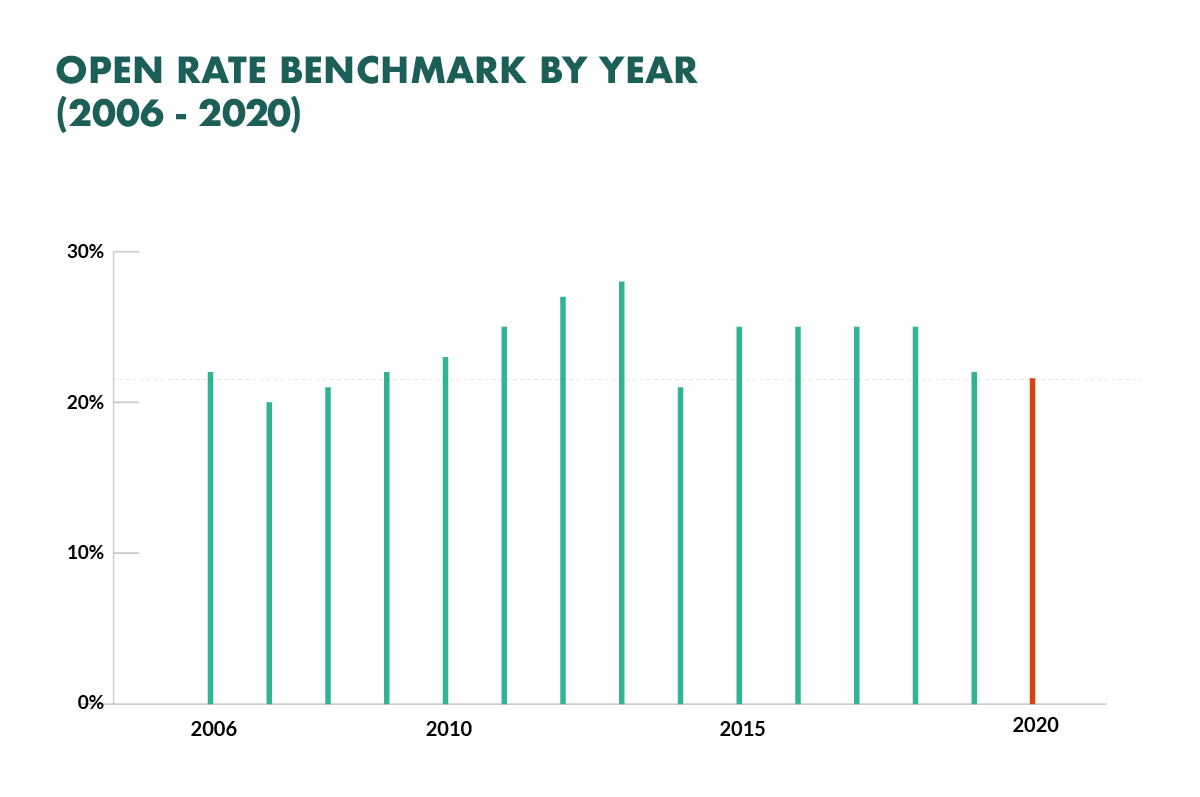
Does a decrease in email open rates signal the death of email marketing?
Of course not.
It’s not the first time open rates will fall and it’s not the last time.
The good news is that based on historical data, we can see that each time there is a decrease, it’s always followed by a strong period of growth. So, we can expect to see an increase again in 2021.
Before you get more people to read your emails, you first need to understand where you stand.
How many people currently ready your emails? What is your current email open rate?
This is where industry benchmark open rate reports comes in.
How do I compare to the industry average?
Benchmark reports are important in understanding of how the industry is changing on the whole and you should find out your own benchmark based on your email campaign performance. You should be able to pull this number from your email service provider.
Here’s a look at our own open rates based on an email campaign we ran earlier this year:
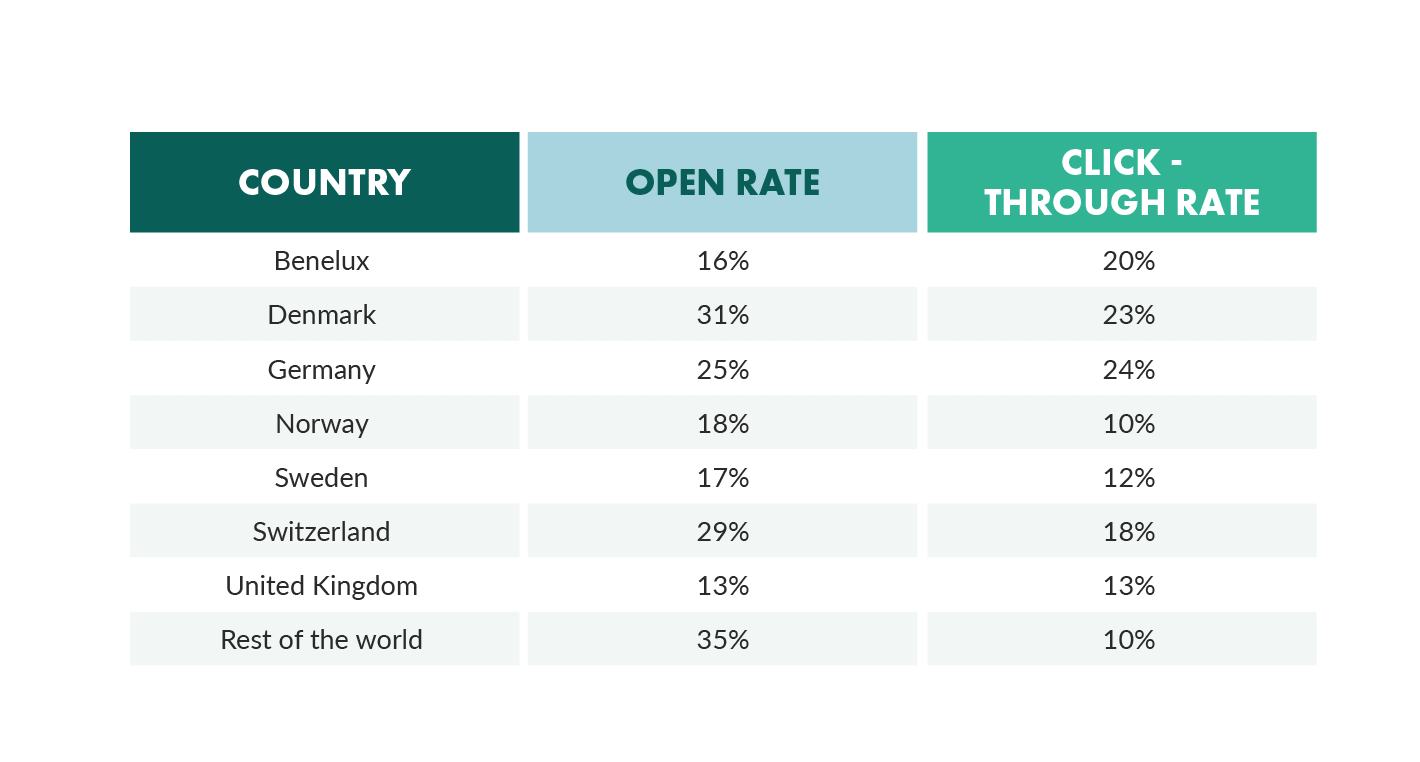
As you can see, open rates differ from country to country.
How do your own email open rates compare?
In 2020, the average open rate across all industries is 21.3%.
If you have an open rate of 22% or higher, then you’re doing great!
If not, don’t worry. You know your email subscribers better than anyone else. For example, if you consistently reach a 15% open rate, which is below average yet your campaign is delivering results, it’s obvious that you are not under performing even if the “industry average” says you are.
Of course, averages are to be taken lightly. Open rates in the insurance industry, for instance, differ from those in the health care industry. And open rates in Europe differ from those in North America.

The first challenge you need to work on is getting your email to your subscriber list. It’s no use spending hours crafting a perfectly optimized campaign if it ends up in your readers’ spam folder, is it?
How do I get more emails delivered?
Think about this:
More than 20% of marketing emails never make it to a subscriber’s inbox. That’s more than one in five emails!
Of course, just like open rate, average deliverabilty rates differ by region.
For example, only 66% of emails reach a reader’s inbox in Asia compared to 86% in Europe.
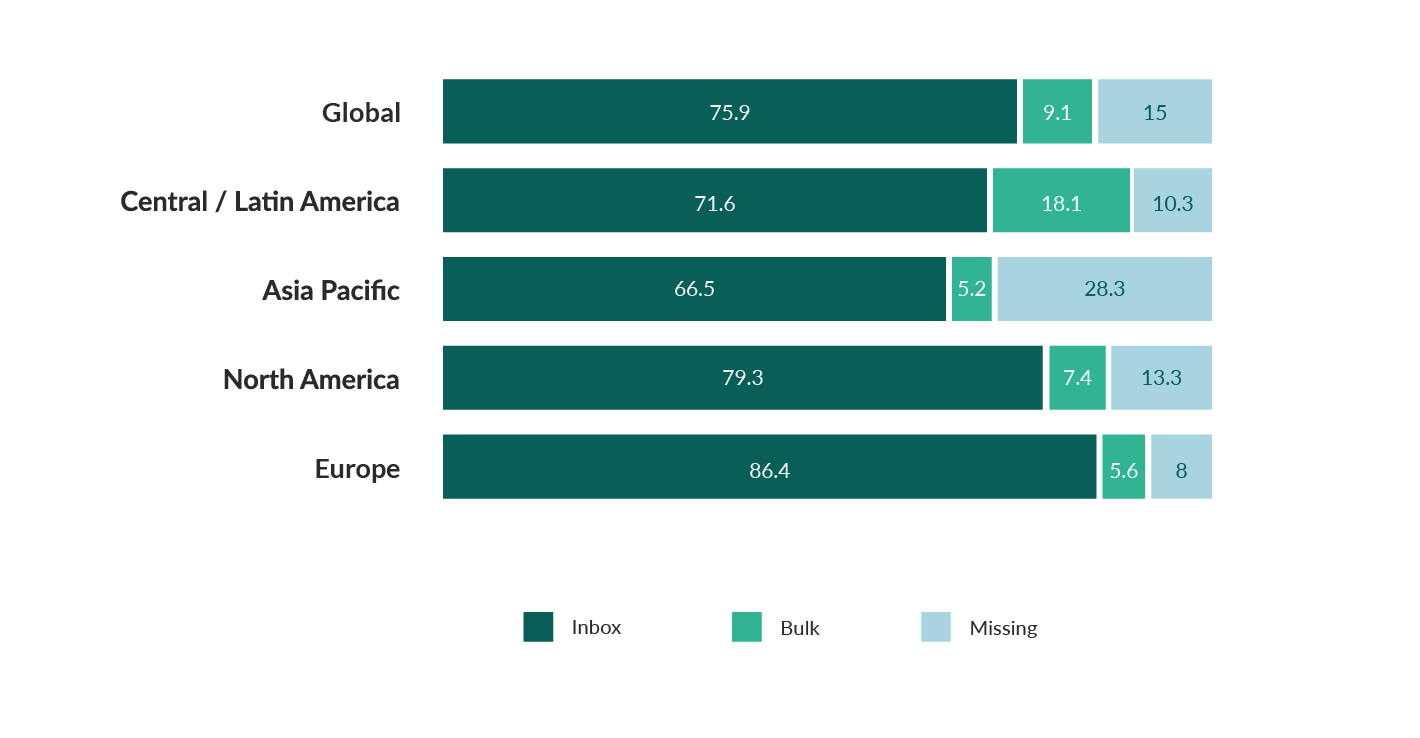
This makes a huge difference to your email open rates!
So, how can you make sure your emails are delivered to your readers?
Here are a few tips on how you can increase delivery rates.
- Use double opt-in. Double opt-in means that the subscriber will verify that she wants to receive emails from your business (although this not a requirement under GDPR). You don’t want to send emails to people who don’t particularly care about them; otherwise, they will not read them and lower your open rates.
- Ask your readers to add you to their trusted address book. By simply asking your readers to add the “from” email address to their contact lists, you can increase the number of emails delivered.
- Cleanse your email list. If a subscriber does not open an email from you three times in a row, the chances are that she is no longer interested in your company. Gmail and Yahoo Mail are smart enough to understand this so if you continue to send emails to subscribers who do not open them, they might be directed to the spam folder, so consider cleansing your list (like JD Whetherspoon did before GDPR).
The more emails that are delivered to your audience, the better chance you have of getting more people to open them.
How do people read my email campaigns?
The way people read emails can provide key insights in how you create your email marketing campaigns.
For example, the type of device they read it on.
Marketers’ can no longer ignore mobile and tablet devices.
Email open rates from mobile devices have grown by more than 100% since 2011 and the percentage of open rates from mobile continues to grow each year!
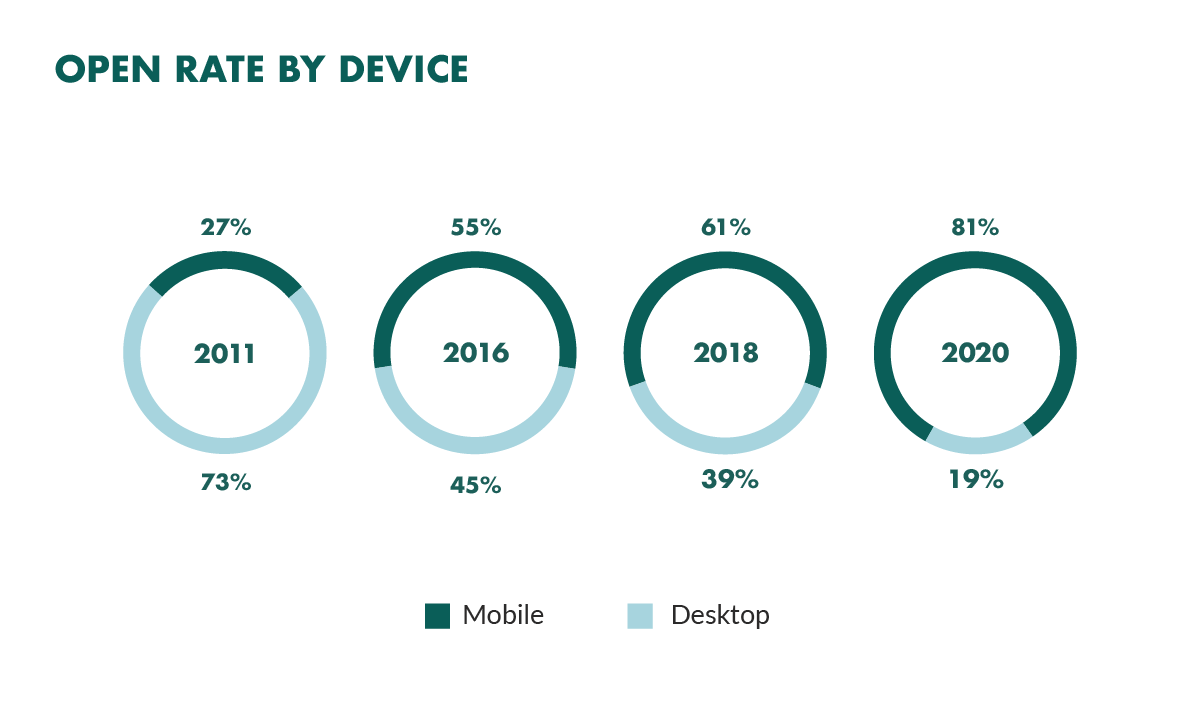
Today, 81% of all emails are now opened and read on mobile devices.
Can you guess what your readers do when you send them an email that isn’t optimized for mobile?
They delete it. In fact, 80% delete the email immediately!
And companies are realizing the importance of email marketing optimization. As many as nine in ten businesses are developing a strategy to optimize their email layout.
Worse still, our own email marketing benchmark report found that only 20% of email campaigns are optimized for mobile devices.
Have you seen how your own email campaign template reads on a mobile device recently?
If not, you should take a look. If you haven’t optimized your email campaigns for mobile devices yet, now is the time.
When should I send my email campaign?
Timing is important to open rates. To know when to send your email campaigns, you have to know your audience.
If you sell software, most of your customers will be enjoying family time on the weekends. That means sending an email campaign on the weekend will lead to fewer opens, if any at all!
So when should you send your email?
Research by Get Response found that the best day to send emails in order to get the highest open rate is on Tuesday.
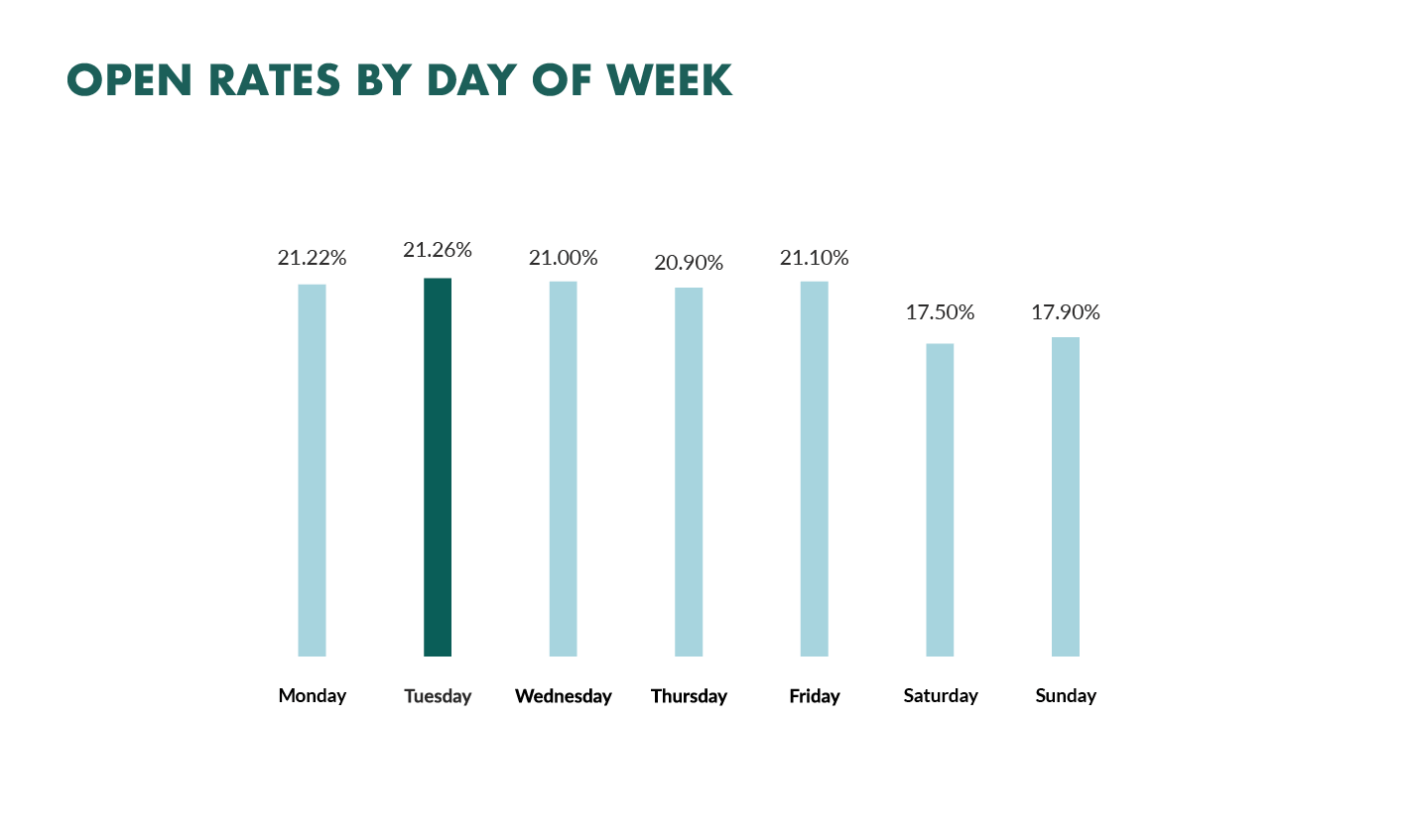
Now that you know on which day to send your emails, what about the time of day?
Further research shows that subscribers are most likely to read your email at either 10am, after they arrived at work, or at 1pm, when they are catching up on their emails after lunch.
And that 23% of all email opens occur during the first hour after delivery. After 24 hours, an email’s chance of being opened drops below 1%!
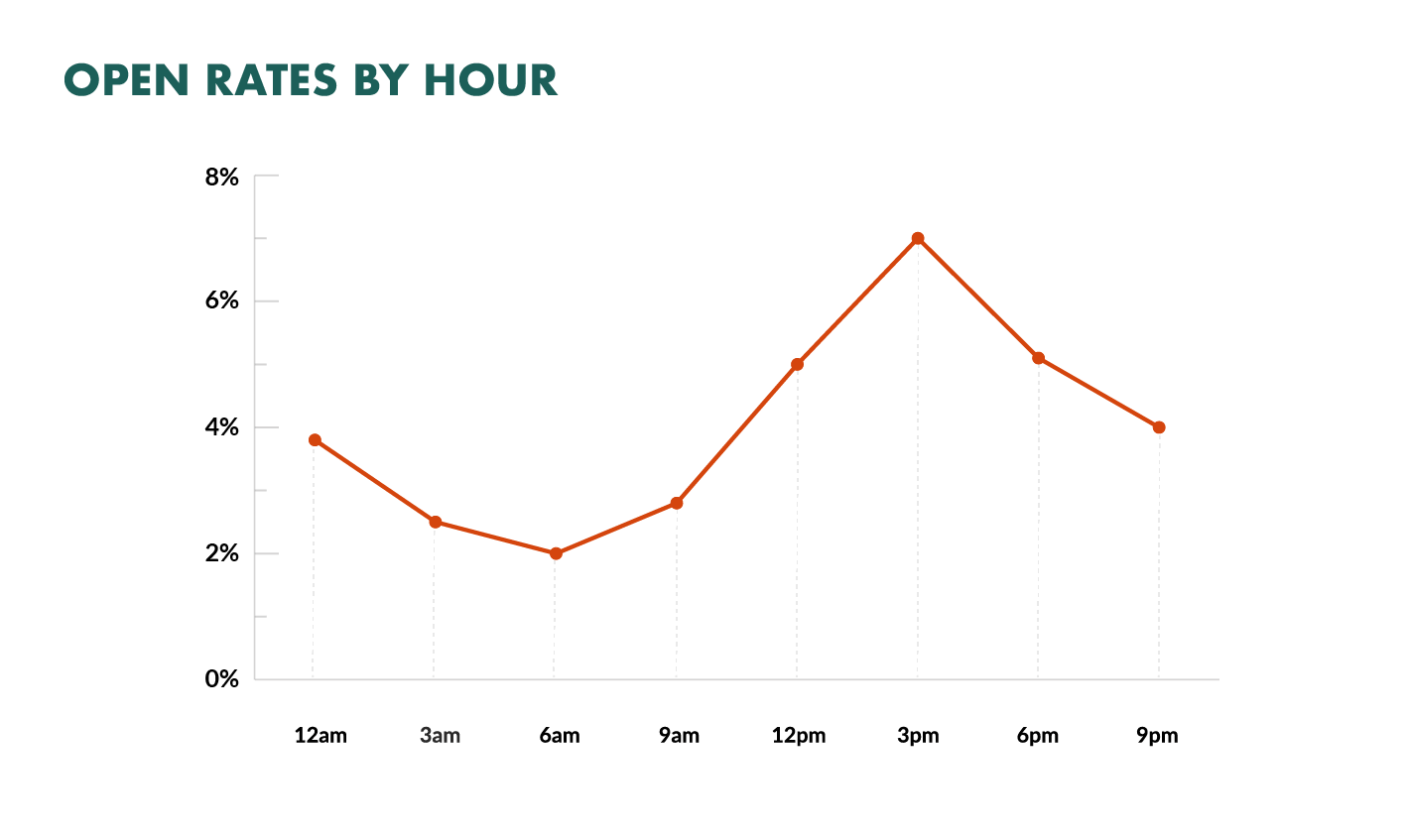
As you see, the timing of when you send your email is crucial to the success of your campaign. If you send it on a day when people are less likely to read your email, then you could be missing out on a lot of interested customers.
So, when it comes to sending out your email campaign, Tuesday, after 1pm. is your best bet.
How do I increase email open rates?
The sender name and subject line of your emails are the most important factors in getting them opened and read.
For example, our own research found that 45% of subscribers say they are likely to read your email because of who it’s from, and 33% of email recipients open an email based on the subject line.
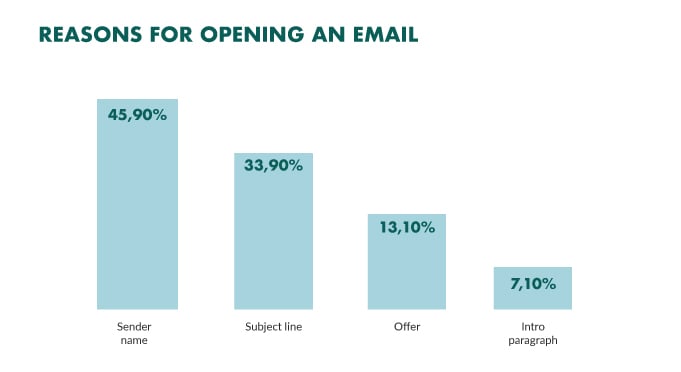
What sender name do you use?
Do you send your emails from company XYZ, or do you use a specific person’s name?
Believe it or not, but this can make a huge difference!
Research from Pinpointe marketing found that by using a specific personal name, rather than a general email address or company name, you can increase open rates by as much as 35%!
Which is why it’s surprising to find that that our own B2B email marketing research found that 89% of email marketing campaigns are sent from a company name.
When it comes to subject lines, have you heard the phrase “you should spend as much time writing your headline as you spend on writing the content”?
Well, the exact same phrase applies to your subject line.
A well crafted subject line shouldn’t be the first thing you think of. Instead, it should take time. And you should use research and data to help guide you.
A report by Retention Science found that subject lines with 6 to 10 words deliver the highest open rate, making 8 words an ideal number for a subject line.
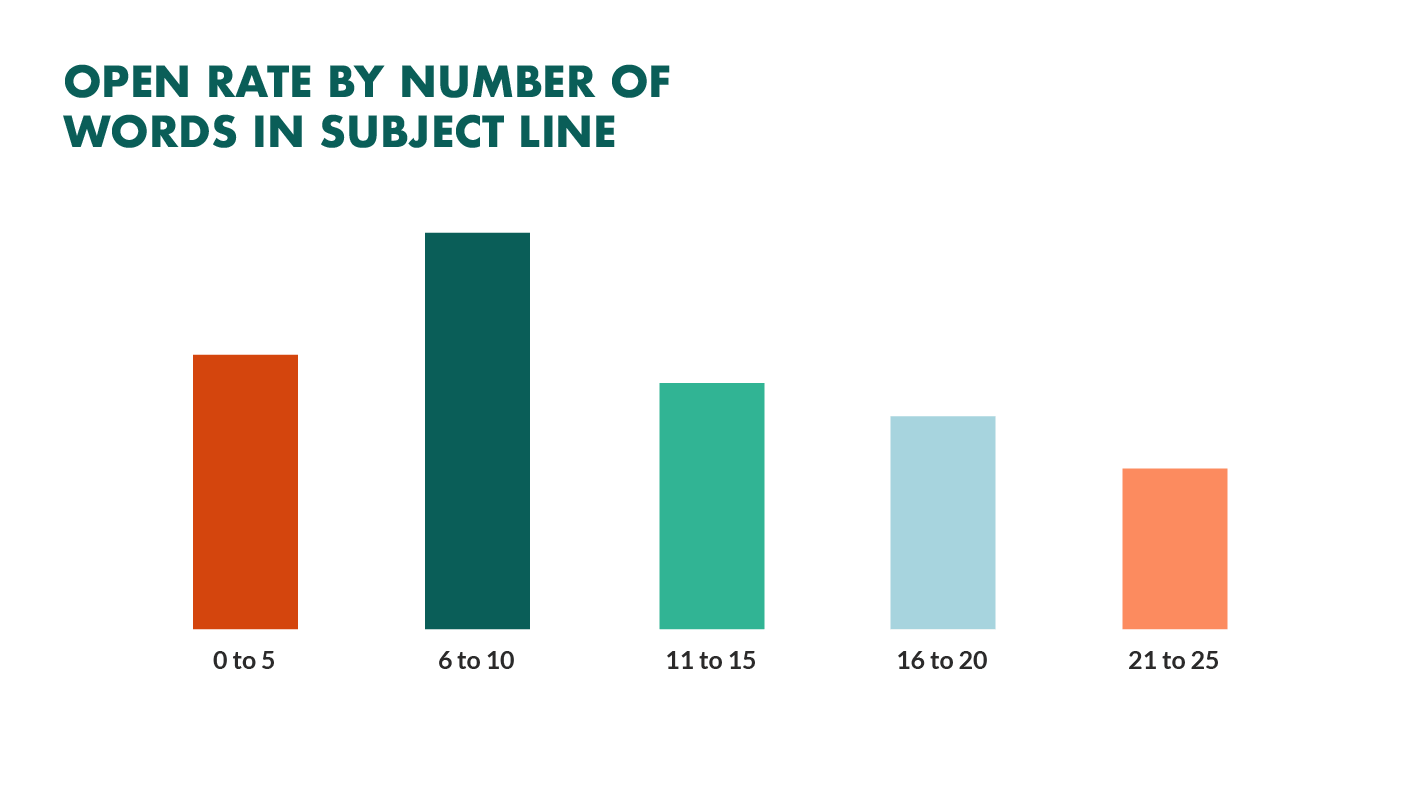
If a subject line is too long, it will get cut off and your reader will not know what the email is about (and could ignore it).
This is especially important for mobile readers as the subject line character length is even shorter – which is why more than 85% of subject lines are shorter than 90 characters!
Another reason for opening an email is if the subject line is addressed to the recipient, as subject lines personalized with a recipient’s first name, for example, can lift open rates by as much as 20%!
Personalized subject lines are still popular, but the results have dropped in 2019.
There is only a 2% improvement if you use personalized subject lines. Today, it’s not enough to add “Hey John” to your subject line to increase open rates. What’s important is how relevant and compelling your message is.
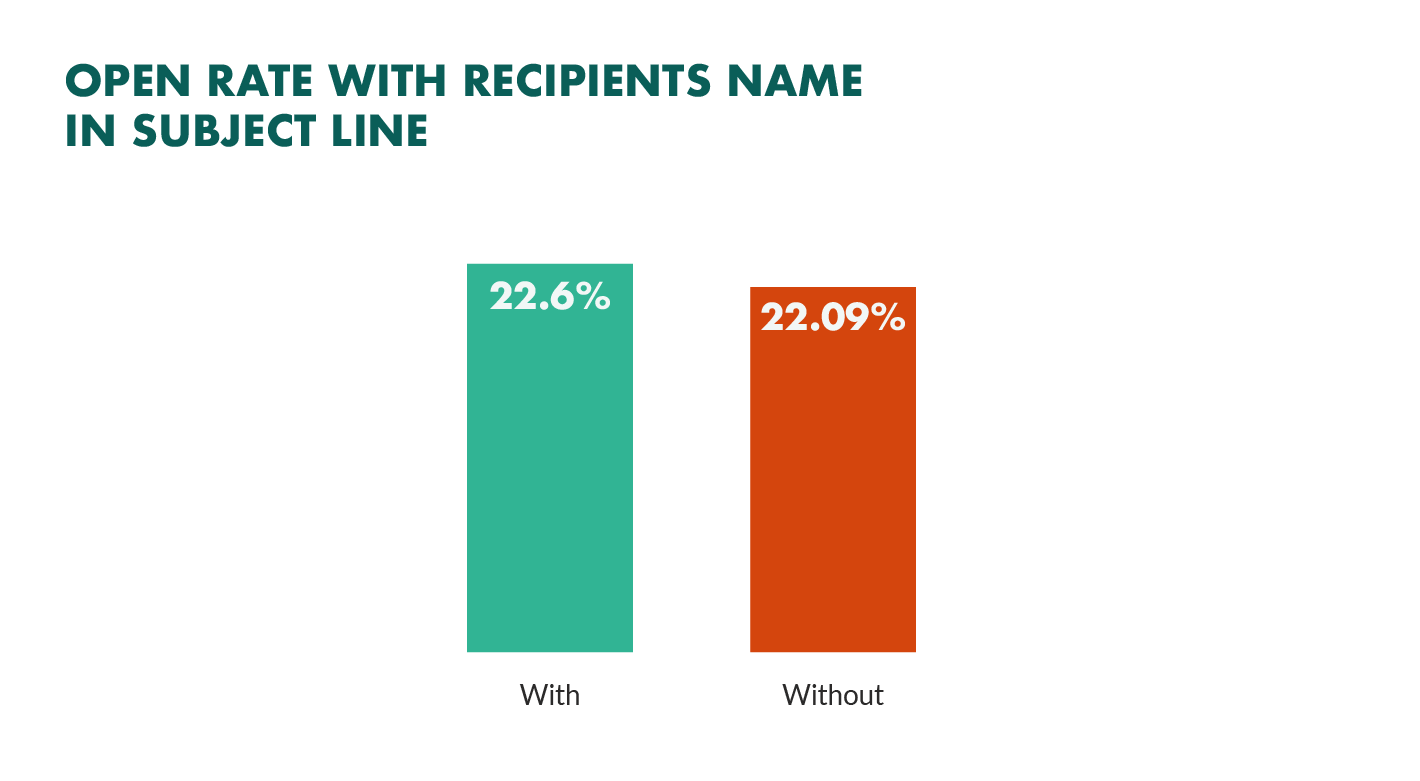
Using a recipients name in a subject line is simple, if you use a CRM.
Of course, if you are feeling super creative, you can take it one step further.
Retention Science found that subject lines with movie titles and song lyrics have an average open rate of 26% (Tweet this!)!
Here’s some ideas for you to start testing with:
- Subject line #1: “Imagine all the people…” got free shipping today!
- Subject line #2: Gone with the wind? Book your summer vacation now
- Subject line #3: 10% discount on all products! I’m all shook up, uh huh huh
(OK, they might be a little lame, but hey I tried!)
If you link to a video within your email, you can also include the word “video” in your subject line. It’s something we have tested and including the word video increased our open rates by 6%!
Are there any words I should use or avoid?
By analyzing billions of emails sent and opened, Dan Zarella was able to find out which words to use and which to avoid in the subject line.
Here’s a look at the findings:
- Most clicked-on emails include these words in the subject line: “secrets”, “e-sales” and “awesome”.
- Emails mostly reported as spam included the words “confirm”, “features” and “upgrade”.
- People are less likely to open emails that include a question mark (?) or a hashtag (#).
Creating the perfect subject line that includes key words proven to increase open rates, and sending the email from a known sender should now be at the top of your to-do list for when you next send out an email.
But wait, what about emoji’s? Should you use emoji’s in your email subject lines? 😍
Well, according to the latest research from Neilsen, the answer is no.
The research compared email subject lines sent with and without an emoji in the subject line and found that emojis in subject lines increase negative sentiment toward an email and do not increase the likelihood of an email being opened
“…all things being equal, adding an emoji to the email does not make people more likely to want to open that email“
Email open rate case study
By now, you’re probably thinking:
“Steven, this sounds really great, but does it work?”
And you know what? If I was reading this article, I would be thinking the same thing!
The good news is that I’ve tested the science. And it works!
Earlier in the post, I referenced that the average open rate in 2019 was 22.15%.
Using the techniques listed above and based on data of more than 99,000 emails sent during the last 10 months, my average email open rate is 40.9%.
That’s right – forty percent!
That’s 85% higher then the average open rate.
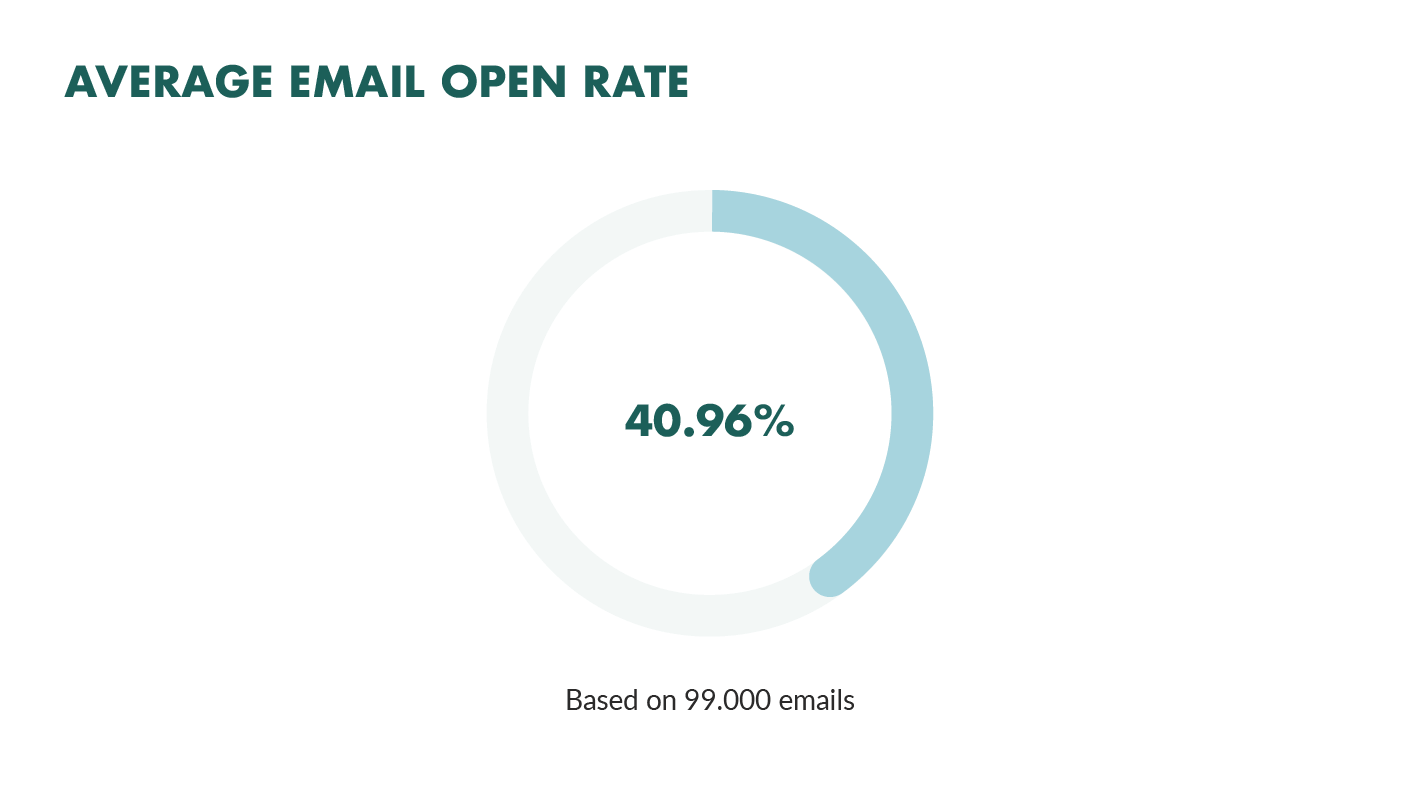
If you’re looking to increase your own email open rates, then try one or two of these techniques the next time you send out a campaign!
How important is segmentation?
Earlier this week, I conducted an email campaign test.
In the test, I sent two emails. The first email was sent to a segmented list (based on interest) and the second was sent to my main blog subscriber list.
The subject line was the same.
And the email content was the same.
Upon viewing the results, the main blog subscriber list generated my average response of a 40% open rate.
I was happy.
But, what happened next blew my mind…
The segmented list earned a staggering 94% open rate!

The sad part is that 89% of marketers do not segment their email list.
Perhaps now is a good time to start segmenting your lists?
(On a side note, the campaign also generated a 30% click-through rate. Improving your click through rate starts with the design. Use these B2B email marketing examples to help you craft a template that’s designed for maximum clicks.)
Conclusion
So there you have it!
I’ve provided the science behind email open rates and the ways you can use the data to make actionable decisions about your email marketing.
Here’s the key points for you to take away and use the next time you send an email to increase email open rates:
- Use 6 to 10 words in your subject lines to get the best open rate
- Send your email campaigns during the work day and after lunch
- Personalize subject lines with the reader’s name
- Use a recognizable sender name
- Optimize your email campaigns for mobile
- Bonus: Segment your email lists
Of course, the best option for you might not be to use any of the above. It depends entirely on what your reports tell you. But you can start with the data provided in this post and use the science to guide you to more get more emails opened.
Author:
Steven MacDonald
EMAIL MARKETING
Unveiling the Future of Email Marketing: 4 Trends to Revolutionize Engagement
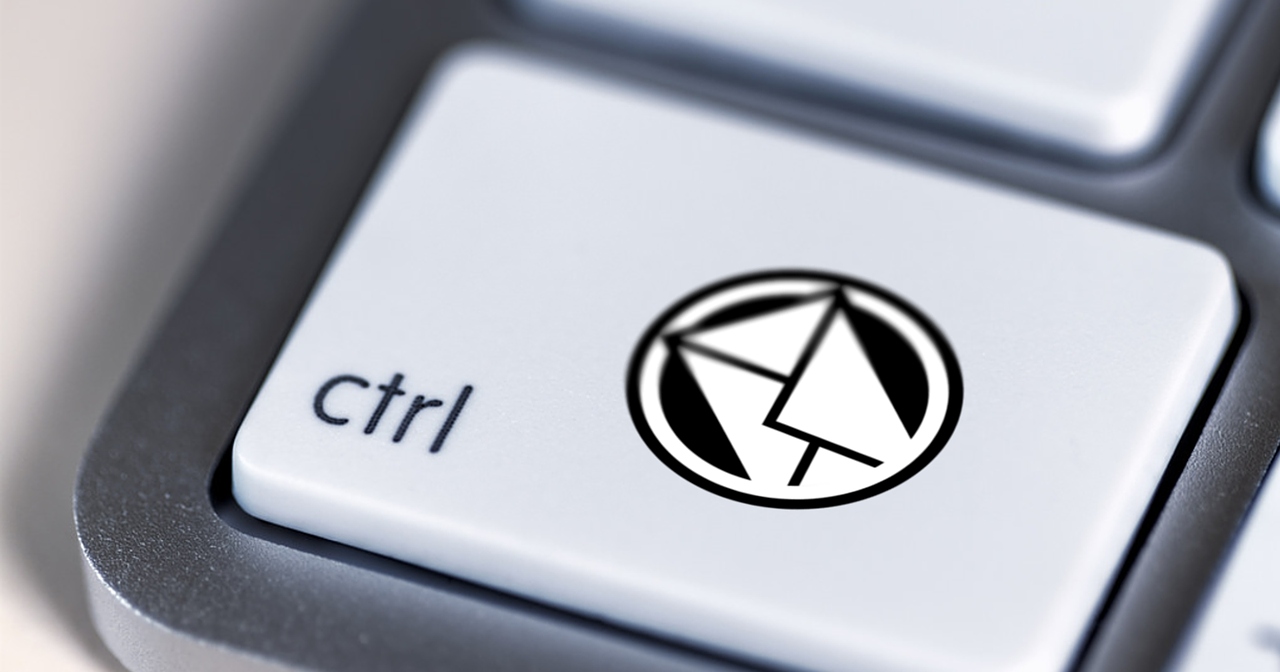
In today’s fast-paced digital landscape, the efficacy of email marketing hinges not only on the delivery of messages but also on their ability to resonate with audiences and drive meaningful interactions. Gone are the days of generic blasts; instead, companies are increasingly turning to innovative strategies to captivate their subscribers. Here, we delve into four emerging trends poised to redefine the realm of email marketing, promising to elevate engagement and drive conversions.
1. User-Generated Content (UGC) Takes Center Stage
User-generated content (UGC) emerges as a potent tool in the arsenal of email marketers, facilitating authentic connections with audiences while amplifying brand visibility. From customer reviews to social media posts, UGC offers a dynamic and relatable portrayal of products and services, resonating with consumers in the era of “new sincerity.”
By harnessing UGC within newsletters, brands gain invaluable insights into consumer preferences and behaviors, fostering trust and credibility. Strategies such as incentivized contests or social media challenges empower users to contribute content willingly, fueling a steady stream of authentic engagement.
2. Augmented and Virtual Realities (AR/VR) Transform Experiences
Augmented reality (AR) and virtual reality (VR) technologies emerge as game-changers in the realm of email marketing, offering immersive experiences that captivate and compel audiences. While VR may require substantial investments and specialized equipment, AR presents a more accessible avenue for brands to showcase products and drive engagement.
From interactive product demonstrations to virtual try-on experiences, AR/VR initiatives promise to revolutionize email campaigns, offering users a glimpse into a digitally enhanced world. While technical constraints may limit current implementations, ongoing advancements herald a future where AR/VR seamlessly integrate into email communication, enriching brand experiences.
3. Omnichannel Integration Enhances Connectivity
The advent of omnichannel marketing heralds a new era of seamless connectivity, enabling brands to orchestrate cohesive experiences across diverse touchpoints. By unifying customer interactions across websites, offline stores, and email communications, businesses cultivate deeper insights and deliver personalized content tailored to individual preferences.
Omnichannel integration not only streamlines the customer journey but also fosters brand loyalty by offering consistent and personalized experiences. Whether browsing online, engaging in-store, or interacting via email, customers encounter a unified brand identity, enhancing engagement and driving conversions.
4. Hyper-Segmentation and Personalization Drive Relevance
In an age defined by personalized experiences, hyper-segmentation emerges as a cornerstone of effective email marketing strategies. By dissecting audiences into granular segments based on demographics, behaviors, and preferences, brands can deliver tailored content that resonates on a profound level.
Utilizing advanced email marketing platforms, businesses can leverage hyper-segmentation to craft personalized campaigns that speak directly to individual interests and needs. From dynamic product recommendations to targeted promotions, personalized emails foster a sense of relevance and exclusivity, driving engagement and fostering long-term customer relationships.
In conclusion, the future of email marketing lies in innovation and adaptation, with brands leveraging cutting-edge technologies and strategic approaches to engage audiences effectively. By embracing trends such as user-generated content, augmented reality, omnichannel integration, and hyper-segmentation, businesses can unlock new realms of engagement, driving meaningful interactions and fostering brand loyalty in an ever-evolving digital landscape.
EMAIL MARKETING
Top Email Marketing Strategies To Use For Q4
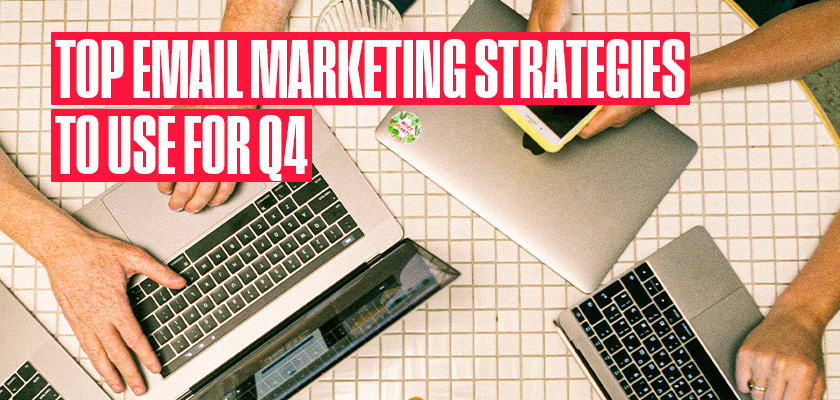
As we approach the Q4 period, it’s never too early to start preparing for your Black Friday and Cyber Monday email marketing strategy. Once Black Friday week hits, our inboxes are filled with a hurricane of brands fighting for attention, each with the ‘biggest’ and the ‘best’ offers you won’t get anywhere else.
To set your brand apart from the competition, it’s crucial to plan ahead. Over 60% of brands send out multiple emails over the course of the Black Friday/ Cyber Monday weekend, and it’s a perfect time to up your brand awareness ahead of the Christmas shopping season.
If you’re not sure where to start with Q4 planning or need some last-minute tips to enhance your strategy, we’ve outlined some top email marketing strategies to incorporate into your plans!
1. Send Pre-Black Friday Emails
Sending pre-Black Friday emails is great for keeping your brand at the forefront of people’s minds ahead of the big day. Not only will a pre-Black Friday email let your audience know about your upcoming event, but it will also ensure that your audience is regularly checking in on your brand throughout the Q4 period.
Additionally, sending pre-Black Friday emails is beneficial for A/B testing. Sending out different formats of emails with minor tweaks, such as the CTAs or subject lines, can help you determine what your audience is more likely to engage with so you can then tailor your Black Friday strategy accordingly.
2. Run a Lead Gen
It might seem like a given, but ahead of Black Friday, it’s beneficial to give your email list a much-needed boost. A simple but effective way to do this is to run a lead-generation advertising campaign. For example, offering your audience the chance to win a prize in return for submitting details, such as their email address, is a quick and easy way to increase your list size. Similarly, refreshing your pop-up on-site with an irresistible offer will also contribute to gaining new profiles.
3. Offer Something Unexpected
Email marketers only have 3 seconds to capture the attention of their readers, which isn’t surprising due to the amount of emails the average person will receive daily. If an email isn’t driving you to click on it, it swiftly gets forgotten about and lost within their inbox. Over Black Friday, to avoid this happening, make sure you’re offering something unexpected, whether that’s a mystery discount or a gift with each purchase!
One of the worst things you can do over Black Friday is to overcomplicate your promotions. If you’re offering multiple promotions and codes, things can get a bit too hectic. To make it as simple as possible, consider running a standard “up to” percentage amount. If you want to include a code, it helps to have this auto-applied at checkout to avoid customers dropping off if they input it incorrectly. In the design of your email, make sure the promotion is clearly highlighted within the design so it can’t be missed, and also referenced in the body copy and subject lines too!
5. Create An Effective Design
Creating an effective design is one thing, but how do you know what works? To improve your email campaigns, consider running an A/B test to pinpoint which elements of your design are improving the CTR and which are hindering it.
Highlighting metrics such as colour, font size, and CTAs can instantly impact whether people will click through or discard! If a consumer clicks on your email, you’ll have, on average, 11 seconds to keep their attention, so making sure your design stands out for the wave of other Black Friday content is key! Keep the design of your email reflective of your branding but with stand-out elements specifically for the shopping season.
6. Make Use Of CTAs
CTAs (call-to-action) are one of the most underrated parts of any email campaign, especially over the Black Friday period. They’re one of the driving forces behind making your email recipients turn into passive readers to customers. One key way to make your CTAs stand out is to make use of bright and bold colours that will attract and hold attention. Additionally, it’s important to think about the placement of your CTAs to increase your click-through rate, make sure the copy used is clear and concise (between two and five words) and use actionable language.
7. Focus On Subject Lines
Subject lines are make or break for every email campaign. Over Black Friday, consumers’ inboxes are cluttered with emails, so it’s important to stand out. It’s estimated that on Black Friday, 116.5 million emails from brands were sent out (more than any other day), and Black Friday sees the highest number of emails opened and clicked. To prevent your emails from being lost in the void, having a cracking subject line to stand out from competitors is everything.
The secret to a great subject line is to keep it short and snappy. On average, subject lines with 50 characters or less tend to get an average of 12% higher open rates and 75% higher click-through rates. Including emojis within subject lines has been seen to increase click-through-rates by as much as 28%!
Additionally, it helps to use language that will really pique your audience’s interest, stay away from any overused cliches and keep them as attention-grabbing as possible.
8. Prep for Cyber Monday
To plan an effective Black Friday, it’s crucial to prepare for Cyber events too. With Cyber following straight after, it’s easy to forget about it or not prioritise it as much as Black Friday, however, it’s still an extremely profitable day! To make the most of it, create dedicated campaigns and tailor your online sales messaging so that it focuses on driving urgency.
9. Incorporate SMS into Your Strategy
Sometimes the importance of SMS can be overlooked because a lot of brands assume that text messages won’t fit in with their brand. However, it’s a no-brainer for reaching even more customers. On average, 82% of people engage with marketing content on their smartphones, so it’s something to definitely explore, especially over the busy shopping period.
To gain SMS sign-ups, you can effectively tie your SMS campaign in with your lead generation and ask for customers to fill out their phone number as well as their email address. That way, they’ll be opted into your send list. It can also be used to send reminders when sales have launched or when offers are coming to a close.
Despite having only 160 characters to work with, SMS campaigns are longer than recommended email subject lines, so it can be just as, if not more effective than email marketing campaigns.
EMAIL MARKETING
Mastering Email A/B Testing for Mobile Apps: The Ultimate Guide

Welcome to the world of email A/B testing for mobile apps!
Here at Favoured, we’re all about delivering the best results for our clients, and that includes mastering the art of email marketing. In this guide, we’ll take you through the essentials of A/B testing your email campaigns to achieve maximum success for your mobile app.
What Is Email A/B Testing?
Email A/B testing, also known as split testing, is a method used to compare two or more variations of an email campaign to determine which one performs better. The goal is to identify the version that resonates most with your target audience, ultimately leading to higher open rates, click-through rates, and overall engagement.
In the context of mobile apps, email A/B testing can be particularly valuable, as it helps you fine-tune your marketing messages to drive user acquisition, engagement, and retention.
Benefits Of Email A/B Testing
There are numerous advantages to incorporating A/B testing into your email marketing strategy for mobile apps. Some of the key benefits include:
- Improved open rates: By testing different subject lines, you can identify which ones capture your audience’s attention and entice them to open your emails.
- Increased click-through rates: Experimenting with various email elements, such as CTAs and layout, can help you determine the most effective ways to encourage recipients to take action.
- Enhanced engagement: A/B testing allows you to create more relevant and engaging content for your target audience, resulting in higher conversion rates and stronger user relationships.
- Data-driven decision making: With A/B testing, you can make informed decisions based on actual user behaviour, rather than relying on assumptions or gut feelings.
Key Metrics To Track
When conducting email A/B tests, it’s essential to track specific metrics to gauge the success of your campaigns. Some of the most critical metrics to monitor include:
- Open rate: The percentage of recipients who open your email. This metric can help you evaluate the effectiveness of your subject lines.
- Click-through rate (CTR): The percentage of recipients who click on a link within your email. A high CTR can indicate that your email content is engaging and relevant.
- Conversion rate: The percentage of recipients who take the desired action after clicking a link in your email, such as downloading your app, making a purchase, or signing up for a newsletter.
- Unsubscribe rate: The percentage of recipients who opt out of receiving future emails from you. A high unsubscribe rate may suggest that your email content is not resonating with your audience.
Understanding the basics of email A/B testing is the first step towards optimising your mobile app marketing campaigns. By grasping the concept, benefits, and key metrics of A/B testing, you’ll be well-equipped to make data-driven decisions that drive real results for your mobile app.
Setting Up Your Test
Defining Your Goal
Before you start setting up your A/B test, it’s crucial to determine the primary objective of your test. Having a clear goal will help you focus your efforts and make data-driven decisions based on the results. Your goal should align with your overall mobile app marketing strategy and be specific, measurable, attainable, relevant, and time-bound (SMART). Examples of goals for email A/B tests include:
- Increasing the open rate by 10% within 30 days
- Boosting the click-through rate by 15% within 60 days
- Reducing the unsubscribe rate by 5% within 45 days
Selecting Variables To Test
Once you’ve set your goal, it’s time to choose the variables to test in your email campaign. The variables you select should have a direct impact on your goal and be something you can measure. Here are some common email elements to consider testing:
- Subject lines: Test different wording, phrasing, or personalisation techniques to capture your audience’s attention.
- Email content: Experiment with different content styles, lengths, or structures to see what resonates with your recipients.
- Call-to-action (CTA): Try various CTA placements, wording, or button designs to encourage users to take the desired action.
- Images and visuals: Test different images, colours, or visual layouts to determine which one drives higher engagement.
- Personalisation: Compare personalised content, such as using the recipient’s name, to generic content to assess its impact on your metrics.
Creating Variations
Now that you’ve chosen your variables, it’s time to create the variations for your email campaigns. Keep the following tips in mind when crafting your variations:
- Limit the number of variations: While it may be tempting to test multiple variations, it’s best to limit yourself to two or three, so you don’t dilute your results or prolong the testing process.
- Make distinct changes: Ensure the variations are different enough to provide meaningful insights. For instance, if testing subject lines, one could be a question, while the other could be a statement.
- Keep other elements consistent: To ensure accurate results, only change the variable you’re testing and keep all other elements the same across variations.
- Consider your audience: When creating variations, take into account your target audience’s preferences and behaviours to craft relevant and engaging content.
Setting up an A/B test for your mobile app’s email campaigns is an essential step towards optimising your marketing efforts. By defining your goal, selecting the right variables to test, and creating effective variations, you’ll be well on your way to enhancing your app’s performance and building stronger relationships with your users.
Implementing & Analysing Your Test
Test Duration & Sample Size
Determining the optimal test duration and sample size is crucial for obtaining accurate and reliable results. Here are some factors to consider when deciding on these parameters:
- Test duration: The length of your test should be long enough to gather sufficient data, but not so long that it delays your marketing efforts. Generally, a test duration of 7 to 14 days is recommended for most email A/B tests.
- Sample size: Your sample size should be large enough to provide statistically significant results. Use an A/B test sample size calculator to determine the appropriate size based on your desired confidence level and the expected difference between variations.
Keep in mind that these recommendations may vary depending on your specific circumstances, such as the size of your email list or the frequency of your email campaigns.
Launching Your Test
Once you’ve determined the test duration and sample size, it’s time to launch your A/B test. Follow these steps to ensure a smooth test launch:
- Segment your email list: Divide your email list into random, equal-sized groups to ensure a fair comparison between variations.
- Send your variations: Schedule your email campaign to send the different variations to the corresponding segments of your email list.
- Monitor the progress: Keep an eye on the key metrics, such as open rates, click-through rates, and conversion rates, throughout the test duration to ensure everything is running smoothly.
Analysing Results & Drawing Conclusions
After your test has concluded, it’s essential to analyse the data, draw conclusions, and apply your findings to future email campaigns. Here’s how to go about it:
- Review the data: Examine the key metrics for each variation and compare them to determine which one performed better.
- Check for statistical significance: Use an A/B test calculator to ensure the differences between the variations are statistically significant, indicating that the results are not due to random chance.
- Draw conclusions: Based on the data, determine what you’ve learned from the test and how it can inform your future email marketing efforts. For instance, if a specific subject line format led to higher open rates, consider using a similar approach in future campaigns.
- Apply your findings: Incorporate your learnings into your email marketing strategy to continually optimise your campaigns and drive better results for your mobile app.
Implementing and analysing your email A/B tests is a critical step towards optimising your mobile app marketing campaigns. By determining the appropriate test duration and sample size, launching your test, and analysing the results, you’ll be able to make data-driven decisions that enhance your app’s performance and foster stronger relationships with your users.
Best Practices
Consistent Testing
To achieve long-term success in email marketing for mobile apps, it’s crucial to make A/B testing a consistent part of your strategy. Regular testing allows you to:
- Continuously optimise your campaigns: Stay ahead of the curve by continually refining your email campaigns based on data-driven insights.
- Adapt to changing trends: Keep your email marketing efforts relevant and up-to-date by adapting to evolving user preferences, industry trends, and market dynamics.
- Validate new ideas: Use A/B testing to validate new marketing concepts or tactics before fully implementing them in your campaigns.
Avoiding Common Pitfalls
As with any marketing endeavour, there are potential pitfalls to watch out for when conducting email A/B tests. Here are some common mistakes and how to avoid them:
- Testing too many variables at once: Focus on testing one variable at a time to ensure accurate results and avoid confusion when analysing the data.
- Ignoring statistical significance: Make sure your test results are statistically significant to avoid drawing conclusions based on random chance or insufficient data.
- Focusing solely on short-term gains: While it’s essential to optimise for immediate results, also consider the long-term impact of your email marketing strategy on user retention and lifetime value.
Utilising Automation & Growth Hacking Strategies
Leveraging automation and growth hacking techniques can help streamline your email A/B testing efforts and drive even better results for your mobile app. Consider the following strategies:
- Email automation: Use email marketing automation tools to schedule and send your A/B tests, track key metrics, and segment your email list efficiently.
- Dynamic content: Implement dynamic content in your email campaigns to personalise messages based on user behaviour, preferences, or demographics, and A/B test the effectiveness of various personalisation techniques.
- Multivariate testing: Once you’re comfortable with A/B testing, consider using multivariate testing to assess the impact of multiple variables simultaneously and identify the best combination of elements for your campaigns.
Mastering email A/B testing for your mobile app is an ongoing process that requires consistent effort, learning, and adaptation. By following best practices, avoiding common pitfalls, and utilising automation and growth hacking strategies, you’ll be well on your way to achieving long-term success in your email marketing campaigns.
As a data-driven full-funnel marketing agency, Favoured believes in the power of optimising every aspect of the customer journey, and that includes email marketing.
We’re dedicated to helping businesses drive real results, and A/B testing plays a crucial role in this process. Reach out if you want to supercharge your email campaigns with us. Happy testing!
-

 SEARCHENGINES6 days ago
SEARCHENGINES6 days agoGoogle Core Update Volatility, Helpful Content Update Gone, Dangerous Google Search Results & Google Ads Confusion
-

 SEO6 days ago
SEO6 days ago10 Paid Search & PPC Planning Best Practices
-

 MARKETING7 days ago
MARKETING7 days ago2 Ways to Take Back the Power in Your Business: Part 2
-

 MARKETING5 days ago
MARKETING5 days ago5 Psychological Tactics to Write Better Emails
-

 SEARCHENGINES5 days ago
SEARCHENGINES5 days agoWeekend Google Core Ranking Volatility
-

 MARKETING6 days ago
MARKETING6 days agoThe power of program management in martech
-

 PPC7 days ago
PPC7 days agoCritical Display Error in Brand Safety Metrics On Twitter/X Corrected
-
SEARCHENGINES4 days ago
Daily Search Forum Recap: April 15, 2024







